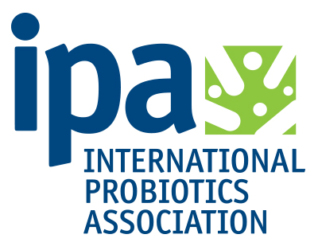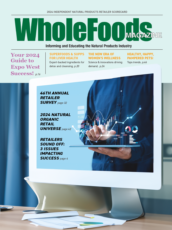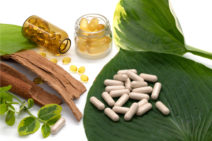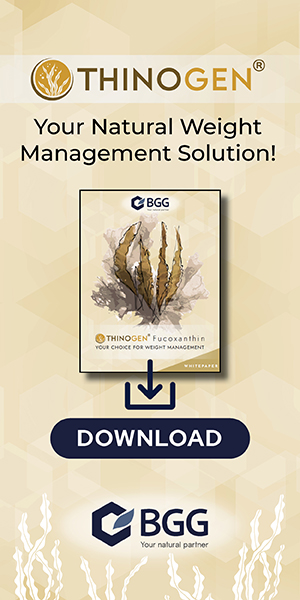
Quicklinks
WholeFoods Magazine
Sperm Health: Role of Semen Microbes
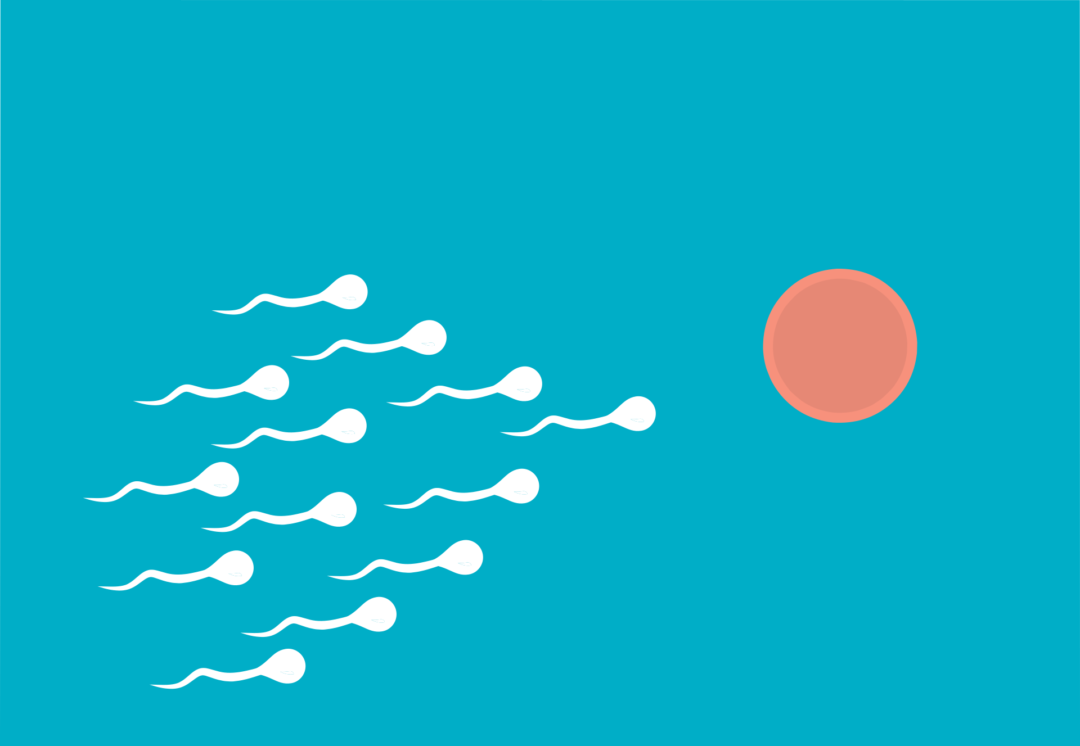
One lone sperm is needed to reach a woman’s ova (egg) to set the stage for human reproduction. Even though healthy male ejaculate (about 2-4 mL) contains as many as 800 million sperm, many men struggle with infertility. Fewer than 15 million sperm per mL of semen is considered a low sperm count, which can interfere with conception.
Two systematic reviews—one conducted in Western countries and another in China— reported significant drops in sperm counts and concentration over the span of a few decades. Lifestyle factors—poor diet, obesity, stress, and smoking— as well as environmental toxins, are thought to be contributing to the changes.
More recently, researchers are studying how the semen microbiota may affect sperm count and quality.
Semen is complex: a mixture of sperm and sexual accessory gland secretions including lipids, proteins, glycans, and inorganic ions.
Rich in nutrients, semen is an ideal milieu for microbial growth. In the past, bacteria in semen were thought to be an explicit sign of infection. However, in animal breeding, seminal microbes have long been recognized to play a role (both positive and negative) in fertility. Advanced technologies such as sequencing techniques have helped identify these organisms as an integral part of the environment.
Derived from Greek roots, the biological terms for conditions of the semen and sperm can be daunting. Fortunately, their meanings are fairly simple.
(Note that a positive semen culture can identify the type and severity of infection by quantifying the colony-forming units. Semen quality is reduced with the increased number of bacterial colonies. Groupings for studies have used 10⁴ CFU/ml (none, less, or more) as a quantifier.)
To identify bacteria in the semen of infertile and fertile men, researchers analyzed 55 observational studies with 51,299 subjects (collected between 1992 and 2019). Results showed that the semen microbiome was rich and diverse in both fertile and infertile men. But the predominant bacteria were different. Ureaplasma urealyticum, Enterococcus faecalis, Mycoplasma hominis and Prevotella negatively impact semen parameters whereas Lactobacillus appeared to protect sperm quality.
Additionally, in a study that compared the semen microbiome of patients with prostatitis (inflammation of the prostate gland) versus healthy controls, a higher amount of lactobacilli, and in particular Lactobacillus iners, was seen in the healthy subjects group.
In a recent review, researchers assembled a concise list of microbial features in semen samples. The authors stressed that these are correlations only and not conclusive or predictive of infertility:
Pathogens are thought to impair spermatozoa functions through various mechanisms:
In addition, the most frequently detected sexually transmitted pathogen Chlamydia trachomatis is linked with male infertility. In a 2022 study of a large cohort of 7,154 infertile males in China, C. trachomatis infection was associated with hypospermia (abnormally low volume of semen ejaculation) and inflammation. However, its role in male infertility remains controversial.
Published in 2020, Microbiota and Human Reproduction: The Case of Male Infertility delves into how the semen microbiota impacts a man’s health. Significantly, evidence suggests a link between semen microbiome dysbiosis and infertility.
Bhandari, Praveen, and Vijay Prabha. “Evaluation of profertility effect of probiotic Lactobacillus plantarum 2621 in a murine model.” The Indian journal of medical research vol. 142,1 (2015): 79-84. doi:10.4103/0971-5916.162127
Cavallini, Giorgio. “Male idiopathic oligoasthenoteratozoospermia.” Asian journal of andrology vol. 8,2 (2006): 143-57. doi:10.1111/j.1745-7262.2006.00123.x
Chen, X L et al. “Antioxidative activity and protective effect of probiotics against high-fat diet-induced sperm damage in rats.” Animal : an international journal of animal bioscience vol. 7,2 (2013): 287-92. doi:10.1017/S1751731112001528
Dardmeh, Fereshteh et al. “Lactobacillus rhamnosus PB01 (DSM 14870) supplementation affects markers of sperm kinematic parameters in a diet-induced obesity mice model.” PloS one vol. 12,10 e0185964. 10 Oct. 2017, doi:10.1371/journal.pone.0185964
Eisenberg, Michael L et al. “Increased risk of incident chronic medical conditions in infertile men: analysis of United States claims data.” Fertility and sterility vol. 105,3 (2016): 629-636. doi:10.1016/j.fertnstert.2015.11.011
Farahani, Linda et al. “The semen microbiome and its impact on sperm function and male fertility: A systematic review and meta-analysis.” Andrology vol. 9,1 (2021): 115-144. doi:10.1111/andr.12886
Gong, Zheng et al. “Lactobacilli inactivate Chlamydia trachomatis through lactic acid but not H2O2.” PloS one vol. 9,9 e107758. 12 Sep. 2014, doi:10.1371/journal.pone.0107758
Jodar, Meritxell et al. “The protein and transcript profiles of human semen.” Cell and tissue research vol. 363,1 (2016): 85-96. doi:10.1007/s00441-015-2237-1
Koedooder, Rivka et al. “Identification and evaluation of the microbiome in the female and male reproductive tracts.” Human reproduction update vol. 25,3 (2019): 298-325. doi:10.1093/humupd/dmy048
Levine, Hagai et al. “Temporal trends in sperm count: a systematic review and meta-regression analysis.” Human reproduction update vol. 23,6 (2017): 646-659. doi:10.1093/humupd/dmx022
Lv, Mo-Qi et al. “Temporal trends in semen concentration and count among 327 373 Chinese healthy men from 1981 to 2019: a systematic review.” Human reproduction (Oxford, England) vol. 36,7 (2021): 1751-1775. doi:10.1093/humrep/deab124
Mändar, Reet et al. “Seminal microbiome in men with and without prostatitis.” International journal of urology : official journal of the Japanese Urological Association vol. 24,3 (2017): 211-216. doi:10.1111/iju.13286
Maretti, C, and G Cavallini. “The association of a probiotic with a prebiotic (Flortec, Bracco) to improve the quality/quantity of spermatozoa in infertile patients with idiopathic oligoasthenoteratospermia: a pilot study.” Andrology vol. 5,3 (2017): 439-444. doi:10.1111/andr.12336
Monteiro, Catarina et al. “Characterization of microbiota in male infertility cases uncovers differences in seminal hyperviscosity and oligoasthenoteratozoospermia possibly correlated with increased prevalence of infectious bacteria.” American journal of reproductive immunology (New York, N.Y. : 1989) vol. 79,6 (2018): e12838. doi:10.1111/aji.12838
Moretti, Elena et al. “The presence of bacteria species in semen and sperm quality.” Journal of assisted reproduction and genetics vol. 26,1 (2009): 47-56. doi:10.1007/s10815-008-9283-5
Schuchardt, Larissa, and Jan Rupp. “Chlamydia trachomatis as the Cause of Infectious Infertility: Acute, Repetitive or Persistent Long-Term Infection?.” Current topics in microbiology and immunology vol. 412 (2018): 159-182. doi:10.1007/82_2016_15
Tomaiuolo, Rossella et al. “Microbiota and Human Reproduction: The Case of Male Infertility.” High-throughput vol. 9,2 10. 13 Apr. 2020, doi:10.3390/ht9020010
Valcarce, D G et al. “Probiotic administration improves sperm quality in asthenozoospermic human donors.” Beneficial microbes vol. 8,2 (2017): 193-206. doi:10.3920/BM2016.0122
Wan, Ling et al. Bacterial culture of donor semen: Analysis of results. National journal of andrology vol. 24,6 (2018): 504-508.
Zhou, Hua et al. “Chlamydia trachomatis infection in the genital tract is associated with inflammation and hypospermia in the infertile male of China.” Asian journal of andrology vol. 24,1 (2022): 56-61. doi:10.4103/aja.aja_54_21
Authorship
Clare Fleishman, MS, RDN, bridges the gap between science and health across most platforms: major newspapers, magazines, books (Globesity), workshops, social media, and websites. In 2010, she launched www.ProbioticsNow.com to share the cascade of discoveries in the microbiome. Always amazed at this “forgotten organ” Fleishman also creates white papers, blogs, videos, and social media for the International Probiotics Association. In 2022, she published a book titled Fertility: Why Microbes, Weight & Nutrition Matter.
The International Probiotics Association (IPA) is a global non-profit organization bringing together through its membership, the probiotic sector’s stakeholders including but not limited to academia, scientists, health care professionals, consumers, industry, and regulators. The IPA’s mission is to promote the safe and efficacious use of probiotics throughout the world. Holding NGO status before Codex Alimentarius, the IPA is also recognized as the unified “Global Voice of Probiotics” around the world.
IPA disclaimer:
Probiotics have different characteristics, qualities and actions that are unique to the specific strain or combinations. The label should identify the genus, species and strain for each microorganism in the product (i.e. Lactobacillus acidophilus IPA001). If a claim pertaining to individual strains or a blend of strains contained in the product is made, the manufacturer should maintain evidence that the amount(s) provided in the product is consistent with the scientific evidence in support of the claim. One lone sperm is needed to reach a woman’s ova (egg) to set the stage for human reproduction. Even though healthy male ejaculate (about 2-4 mL) contains as many as 800 million sperm, many men struggle with infertility. Fewer than 15 million sperm per mL of semen is considered a low sperm count, which can interfere with conception.
Two systematic reviews—one conducted in Western countries and another in China— reported significant drops in sperm counts and concentration over the span of a few decades. Lifestyle factors—poor diet, obesity, stress, and smoking— as well as environmental toxins, are thought to be contributing to the changes.
More recently, researchers are studying how the semen microbiota may affect sperm count and quality.
Semen is complex: a mixture of sperm and sexual accessory gland secretions including lipids, proteins, glycans, and inorganic ions.
Rich in nutrients, semen is an ideal milieu for microbial growth. In the past, bacteria in semen were thought to be an explicit sign of infection. However, in animal breeding, seminal microbes have long been recognized to play a role (both positive and negative) in fertility. Advanced technologies such as sequencing techniques have helped identify these organisms as an integral part of the environment.
Derived from Greek roots, the biological terms for conditions of the semen and sperm can be daunting. Fortunately, their meanings are fairly simple.
(Note that a positive semen culture can identify the type and severity of infection by quantifying the colony-forming units. Semen quality is reduced with the increased number of bacterial colonies. Groupings for studies have used 10⁴ CFU/ml (none, less, or more) as a quantifier.)
To identify bacteria in the semen of infertile and fertile men, researchers analyzed 55 observational studies with 51,299 subjects (collected between 1992 and 2019). Results showed that the semen microbiome was rich and diverse in both fertile and infertile men. But the predominant bacteria were different. Ureaplasma urealyticum, Enterococcus faecalis, Mycoplasma hominis and Prevotella negatively impact semen parameters whereas Lactobacillus appeared to protect sperm quality.
Additionally, in a study that compared the semen microbiome of patients with prostatitis (inflammation of the prostate gland) versus healthy controls, a higher amount of lactobacilli, and in particular Lactobacillus iners, was seen in the healthy subjects group.
In a recent review, researchers assembled a concise list of microbial features in semen samples. The authors stressed that these are correlations only and not conclusive or predictive of infertility:
Pathogens are thought to impair spermatozoa functions through various mechanisms:
In addition, the most frequently detected sexually transmitted pathogen Chlamydia trachomatis is linked with male infertility. In a 2022 study of a large cohort of 7,154 infertile males in China, C. trachomatis infection was associated with hypospermia (abnormally low volume of semen ejaculation) and inflammation. However, its role in male infertility remains controversial.
Published in 2020, Microbiota and Human Reproduction: The Case of Male Infertility delves into how the semen microbiota impacts a man’s health. Significantly, evidence suggests a link between semen microbiome dysbiosis and infertility.
Bhandari, Praveen, and Vijay Prabha. “Evaluation of profertility effect of probiotic Lactobacillus plantarum 2621 in a murine model.” The Indian journal of medical research vol. 142,1 (2015): 79-84. doi:10.4103/0971-5916.162127
Cavallini, Giorgio. “Male idiopathic oligoasthenoteratozoospermia.” Asian journal of andrology vol. 8,2 (2006): 143-57. doi:10.1111/j.1745-7262.2006.00123.x
Chen, X L et al. “Antioxidative activity and protective effect of probiotics against high-fat diet-induced sperm damage in rats.” Animal : an international journal of animal bioscience vol. 7,2 (2013): 287-92. doi:10.1017/S1751731112001528
Dardmeh, Fereshteh et al. “Lactobacillus rhamnosus PB01 (DSM 14870) supplementation affects markers of sperm kinematic parameters in a diet-induced obesity mice model.” PloS one vol. 12,10 e0185964. 10 Oct. 2017, doi:10.1371/journal.pone.0185964
Eisenberg, Michael L et al. “Increased risk of incident chronic medical conditions in infertile men: analysis of United States claims data.” Fertility and sterility vol. 105,3 (2016): 629-636. doi:10.1016/j.fertnstert.2015.11.011
Farahani, Linda et al. “The semen microbiome and its impact on sperm function and male fertility: A systematic review and meta-analysis.” Andrology vol. 9,1 (2021): 115-144. doi:10.1111/andr.12886
Gong, Zheng et al. “Lactobacilli inactivate Chlamydia trachomatis through lactic acid but not H2O2.” PloS one vol. 9,9 e107758. 12 Sep. 2014, doi:10.1371/journal.pone.0107758
Jodar, Meritxell et al. “The protein and transcript profiles of human semen.” Cell and tissue research vol. 363,1 (2016): 85-96. doi:10.1007/s00441-015-2237-1
Koedooder, Rivka et al. “Identification and evaluation of the microbiome in the female and male reproductive tracts.” Human reproduction update vol. 25,3 (2019): 298-325. doi:10.1093/humupd/dmy048
Levine, Hagai et al. “Temporal trends in sperm count: a systematic review and meta-regression analysis.” Human reproduction update vol. 23,6 (2017): 646-659. doi:10.1093/humupd/dmx022
Lv, Mo-Qi et al. “Temporal trends in semen concentration and count among 327 373 Chinese healthy men from 1981 to 2019: a systematic review.” Human reproduction (Oxford, England) vol. 36,7 (2021): 1751-1775. doi:10.1093/humrep/deab124
Mändar, Reet et al. “Seminal microbiome in men with and without prostatitis.” International journal of urology : official journal of the Japanese Urological Association vol. 24,3 (2017): 211-216. doi:10.1111/iju.13286
Maretti, C, and G Cavallini. “The association of a probiotic with a prebiotic (Flortec, Bracco) to improve the quality/quantity of spermatozoa in infertile patients with idiopathic oligoasthenoteratospermia: a pilot study.” Andrology vol. 5,3 (2017): 439-444. doi:10.1111/andr.12336
Monteiro, Catarina et al. “Characterization of microbiota in male infertility cases uncovers differences in seminal hyperviscosity and oligoasthenoteratozoospermia possibly correlated with increased prevalence of infectious bacteria.” American journal of reproductive immunology (New York, N.Y. : 1989) vol. 79,6 (2018): e12838. doi:10.1111/aji.12838
Moretti, Elena et al. “The presence of bacteria species in semen and sperm quality.” Journal of assisted reproduction and genetics vol. 26,1 (2009): 47-56. doi:10.1007/s10815-008-9283-5
Schuchardt, Larissa, and Jan Rupp. “Chlamydia trachomatis as the Cause of Infectious Infertility: Acute, Repetitive or Persistent Long-Term Infection?.” Current topics in microbiology and immunology vol. 412 (2018): 159-182. doi:10.1007/82_2016_15
Tomaiuolo, Rossella et al. “Microbiota and Human Reproduction: The Case of Male Infertility.” High-throughput vol. 9,2 10. 13 Apr. 2020, doi:10.3390/ht9020010
Valcarce, D G et al. “Probiotic administration improves sperm quality in asthenozoospermic human donors.” Beneficial microbes vol. 8,2 (2017): 193-206. doi:10.3920/BM2016.0122
Wan, Ling et al. Bacterial culture of donor semen: Analysis of results. National journal of andrology vol. 24,6 (2018): 504-508.
Zhou, Hua et al. “Chlamydia trachomatis infection in the genital tract is associated with inflammation and hypospermia in the infertile male of China.” Asian journal of andrology vol. 24,1 (2022): 56-61. doi:10.4103/aja.aja_54_21
Authorship
Clare Fleishman, MS, RDN, bridges the gap between science and health across most platforms: major newspapers, magazines, books (Globesity), workshops, social media, and websites. In 2010, she launched www.ProbioticsNow.com to share the cascade of discoveries in the microbiome. Always amazed at this “forgotten organ” Fleishman also creates white papers, blogs, videos, and social media for the International Probiotics Association. In 2022, she published a book titled Fertility: Why Microbes, Weight & Nutrition Matter.
The International Probiotics Association (IPA) is a global non-profit organization bringing together through its membership, the probiotic sector’s stakeholders including but not limited to academia, scientists, health care professionals, consumers, industry, and regulators. The IPA’s mission is to promote the safe and efficacious use of probiotics throughout the world. Holding NGO status before Codex Alimentarius, the IPA is also recognized as the unified “Global Voice of Probiotics” around the world.
IPA disclaimer:
Probiotics have different characteristics, qualities and actions that are unique to the specific strain or combinations. The label should identify the genus, species and strain for each microorganism in the product (i.e. Lactobacillus acidophilus IPA001). If a claim pertaining to individual strains or a blend of strains contained in the product is made, the manufacturer should maintain evidence that the amount(s) provided in the product is consistent with the scientific evidence in support of the claim.
Two systematic reviews—one conducted in Western countries and another in China— reported significant drops in sperm counts and concentration over the span of a few decades. Lifestyle factors—poor diet, obesity, stress, and smoking— as well as environmental toxins, are thought to be contributing to the changes.
More recently, researchers are studying how the semen microbiota may affect sperm count and quality.
Semen, in brief
Long considered a mere messenger of male DNA, the seminal fluid provides components that allow the sperm to successfully reach and fertilize the egg and prepare the female immune system to tolerate the embryo.Semen is complex: a mixture of sperm and sexual accessory gland secretions including lipids, proteins, glycans, and inorganic ions.
Rich in nutrients, semen is an ideal milieu for microbial growth. In the past, bacteria in semen were thought to be an explicit sign of infection. However, in animal breeding, seminal microbes have long been recognized to play a role (both positive and negative) in fertility. Advanced technologies such as sequencing techniques have helped identify these organisms as an integral part of the environment.
Sperm, in brief
Optimum sperm numbers, shape, and movement are critical to successful reproduction.Derived from Greek roots, the biological terms for conditions of the semen and sperm can be daunting. Fortunately, their meanings are fairly simple.
- Aspermia: Lack of semen
- Hypospermia: Semen volume below normal
- Asthenozoospermia: Reduced sperm motility
- Oligozoospermia: Low sperm count
- Teratozoospermia: Abnormal sperm shape
- Oligoasthenozoospermia: Combination of asthenozoospermia (reduced sperm motility) and oligozoospermia (low number of sperm)
- Oligoasthenoteratozoospermia: A condition that includes oligozoospermia (low number of sperm), asthenozoospermia (poor sperm movement), and teratozoospermia (abnormal sperm shape)
Semen microbes in fertility
Semen microbiota may be different in fertile and infertile men.(Note that a positive semen culture can identify the type and severity of infection by quantifying the colony-forming units. Semen quality is reduced with the increased number of bacterial colonies. Groupings for studies have used 10⁴ CFU/ml (none, less, or more) as a quantifier.)
To identify bacteria in the semen of infertile and fertile men, researchers analyzed 55 observational studies with 51,299 subjects (collected between 1992 and 2019). Results showed that the semen microbiome was rich and diverse in both fertile and infertile men. But the predominant bacteria were different. Ureaplasma urealyticum, Enterococcus faecalis, Mycoplasma hominis and Prevotella negatively impact semen parameters whereas Lactobacillus appeared to protect sperm quality.
Additionally, in a study that compared the semen microbiome of patients with prostatitis (inflammation of the prostate gland) versus healthy controls, a higher amount of lactobacilli, and in particular Lactobacillus iners, was seen in the healthy subjects group.
In a recent review, researchers assembled a concise list of microbial features in semen samples. The authors stressed that these are correlations only and not conclusive or predictive of infertility:
- Good-quality semen: lactobacilli
- Low-quality semen: Anaeroccus, Bacteroides ureolyticus, Proteobacteria, Prevotella-predominant
- Azoospermic semen (no sperm in a man’s ejaculate): Bacteroidetes and Firmicutes
Pathogens are thought to impair spermatozoa functions through various mechanisms:
- Agglutination (clumping) of motile sperm
- Induction of apoptosis (programmed cell death)
- Production of immobilization factors
- Impairment of the acrosome reaction, a required step before the sperm fertilizes the egg
In addition, the most frequently detected sexually transmitted pathogen Chlamydia trachomatis is linked with male infertility. In a 2022 study of a large cohort of 7,154 infertile males in China, C. trachomatis infection was associated with hypospermia (abnormally low volume of semen ejaculation) and inflammation. However, its role in male infertility remains controversial.
Published in 2020, Microbiota and Human Reproduction: The Case of Male Infertility delves into how the semen microbiota impacts a man’s health. Significantly, evidence suggests a link between semen microbiome dysbiosis and infertility.
Targeting the Seminal Microbiome
Probiotics
The following trials in animals and humans illustrate improved sperm parameters with specific strains of probiotic bacteria:Animals
- A strain of Lacticaseibacillus rhamnosus improved sperm quality parameters in obese mouse models.
- A study with rats found that oral probiotics (lactobacilli and Bacillus spp.) had antioxidant activity and a protective effect against sperm damage induced by a high-fat diet.
Humans
- In a study in humans, specific strains of Lacticaseibacillus rhamnosus and Bifidobacterium longum improved sperm motility and reduced the percentage of sperm DNA fragmentation in asthenozoospermic (reduced sperm motility) males.
- And in another study, a combination of three strains of lactobacilli (Levilactobacillus brevis, Ligilactobacillus salivarius, and Lactiplantibacillus plantarum) used as vaginal tablets to treat bacterial vaginosis prevented sperm lipid peroxidation (oxidative degradation) and preserved sperm motility and viability.
Prebiotics
Prebiotics were able to ameliorate some semen parameters in both animal models and humans.Synbiotics
A synbiotic of a specific strain of Lacticaseibacillus paracasei with added prebiotics and additional ingredients over a period of 6 months improved sperm count and motility, and reduced the rate of atypical forms, in comparison to the control group.Takeaway
Emerging evidence suggests that semen microbiome may affect sperm numbers and quality. Further studies are needed to improve our knowledge regarding the semen microbiome and explore its manipulation as a tool for improving sperm parameters.
Read more from the International Probiotics Association (IPA).
Key references
Barbonetti, Arcangelo et al. “Effect of vaginal probiotic lactobacilli on in vitro-induced sperm lipid peroxidation and its impact on sperm motility and viability.” Fertility and sterility vol. 95,8 (2011): 2485-8. doi:10.1016/j.fertnstert.2011.03.066Bhandari, Praveen, and Vijay Prabha. “Evaluation of profertility effect of probiotic Lactobacillus plantarum 2621 in a murine model.” The Indian journal of medical research vol. 142,1 (2015): 79-84. doi:10.4103/0971-5916.162127
Cavallini, Giorgio. “Male idiopathic oligoasthenoteratozoospermia.” Asian journal of andrology vol. 8,2 (2006): 143-57. doi:10.1111/j.1745-7262.2006.00123.x
Chen, X L et al. “Antioxidative activity and protective effect of probiotics against high-fat diet-induced sperm damage in rats.” Animal : an international journal of animal bioscience vol. 7,2 (2013): 287-92. doi:10.1017/S1751731112001528
Dardmeh, Fereshteh et al. “Lactobacillus rhamnosus PB01 (DSM 14870) supplementation affects markers of sperm kinematic parameters in a diet-induced obesity mice model.” PloS one vol. 12,10 e0185964. 10 Oct. 2017, doi:10.1371/journal.pone.0185964
Eisenberg, Michael L et al. “Increased risk of incident chronic medical conditions in infertile men: analysis of United States claims data.” Fertility and sterility vol. 105,3 (2016): 629-636. doi:10.1016/j.fertnstert.2015.11.011
Farahani, Linda et al. “The semen microbiome and its impact on sperm function and male fertility: A systematic review and meta-analysis.” Andrology vol. 9,1 (2021): 115-144. doi:10.1111/andr.12886
Gong, Zheng et al. “Lactobacilli inactivate Chlamydia trachomatis through lactic acid but not H2O2.” PloS one vol. 9,9 e107758. 12 Sep. 2014, doi:10.1371/journal.pone.0107758
Jodar, Meritxell et al. “The protein and transcript profiles of human semen.” Cell and tissue research vol. 363,1 (2016): 85-96. doi:10.1007/s00441-015-2237-1
Koedooder, Rivka et al. “Identification and evaluation of the microbiome in the female and male reproductive tracts.” Human reproduction update vol. 25,3 (2019): 298-325. doi:10.1093/humupd/dmy048
Levine, Hagai et al. “Temporal trends in sperm count: a systematic review and meta-regression analysis.” Human reproduction update vol. 23,6 (2017): 646-659. doi:10.1093/humupd/dmx022
Lv, Mo-Qi et al. “Temporal trends in semen concentration and count among 327 373 Chinese healthy men from 1981 to 2019: a systematic review.” Human reproduction (Oxford, England) vol. 36,7 (2021): 1751-1775. doi:10.1093/humrep/deab124
Mändar, Reet et al. “Seminal microbiome in men with and without prostatitis.” International journal of urology : official journal of the Japanese Urological Association vol. 24,3 (2017): 211-216. doi:10.1111/iju.13286
Maretti, C, and G Cavallini. “The association of a probiotic with a prebiotic (Flortec, Bracco) to improve the quality/quantity of spermatozoa in infertile patients with idiopathic oligoasthenoteratospermia: a pilot study.” Andrology vol. 5,3 (2017): 439-444. doi:10.1111/andr.12336
Monteiro, Catarina et al. “Characterization of microbiota in male infertility cases uncovers differences in seminal hyperviscosity and oligoasthenoteratozoospermia possibly correlated with increased prevalence of infectious bacteria.” American journal of reproductive immunology (New York, N.Y. : 1989) vol. 79,6 (2018): e12838. doi:10.1111/aji.12838
Moretti, Elena et al. “The presence of bacteria species in semen and sperm quality.” Journal of assisted reproduction and genetics vol. 26,1 (2009): 47-56. doi:10.1007/s10815-008-9283-5
Schuchardt, Larissa, and Jan Rupp. “Chlamydia trachomatis as the Cause of Infectious Infertility: Acute, Repetitive or Persistent Long-Term Infection?.” Current topics in microbiology and immunology vol. 412 (2018): 159-182. doi:10.1007/82_2016_15
Tomaiuolo, Rossella et al. “Microbiota and Human Reproduction: The Case of Male Infertility.” High-throughput vol. 9,2 10. 13 Apr. 2020, doi:10.3390/ht9020010
Valcarce, D G et al. “Probiotic administration improves sperm quality in asthenozoospermic human donors.” Beneficial microbes vol. 8,2 (2017): 193-206. doi:10.3920/BM2016.0122
Wan, Ling et al. Bacterial culture of donor semen: Analysis of results. National journal of andrology vol. 24,6 (2018): 504-508.
Zhou, Hua et al. “Chlamydia trachomatis infection in the genital tract is associated with inflammation and hypospermia in the infertile male of China.” Asian journal of andrology vol. 24,1 (2022): 56-61. doi:10.4103/aja.aja_54_21
Authorship
Clare Fleishman, MS, RDN, bridges the gap between science and health across most platforms: major newspapers, magazines, books (Globesity), workshops, social media, and websites. In 2010, she launched www.ProbioticsNow.com to share the cascade of discoveries in the microbiome. Always amazed at this “forgotten organ” Fleishman also creates white papers, blogs, videos, and social media for the International Probiotics Association. In 2022, she published a book titled Fertility: Why Microbes, Weight & Nutrition Matter.
The International Probiotics Association (IPA) is a global non-profit organization bringing together through its membership, the probiotic sector’s stakeholders including but not limited to academia, scientists, health care professionals, consumers, industry, and regulators. The IPA’s mission is to promote the safe and efficacious use of probiotics throughout the world. Holding NGO status before Codex Alimentarius, the IPA is also recognized as the unified “Global Voice of Probiotics” around the world.
IPA disclaimer:
Probiotics have different characteristics, qualities and actions that are unique to the specific strain or combinations. The label should identify the genus, species and strain for each microorganism in the product (i.e. Lactobacillus acidophilus IPA001). If a claim pertaining to individual strains or a blend of strains contained in the product is made, the manufacturer should maintain evidence that the amount(s) provided in the product is consistent with the scientific evidence in support of the claim. One lone sperm is needed to reach a woman’s ova (egg) to set the stage for human reproduction. Even though healthy male ejaculate (about 2-4 mL) contains as many as 800 million sperm, many men struggle with infertility. Fewer than 15 million sperm per mL of semen is considered a low sperm count, which can interfere with conception.
Two systematic reviews—one conducted in Western countries and another in China— reported significant drops in sperm counts and concentration over the span of a few decades. Lifestyle factors—poor diet, obesity, stress, and smoking— as well as environmental toxins, are thought to be contributing to the changes.
More recently, researchers are studying how the semen microbiota may affect sperm count and quality.
Semen, in brief
Long considered a mere messenger of male DNA, the seminal fluid provides components that allow the sperm to successfully reach and fertilize the egg and prepare the female immune system to tolerate the embryo.Semen is complex: a mixture of sperm and sexual accessory gland secretions including lipids, proteins, glycans, and inorganic ions.
Rich in nutrients, semen is an ideal milieu for microbial growth. In the past, bacteria in semen were thought to be an explicit sign of infection. However, in animal breeding, seminal microbes have long been recognized to play a role (both positive and negative) in fertility. Advanced technologies such as sequencing techniques have helped identify these organisms as an integral part of the environment.
Sperm, in brief
Optimum sperm numbers, shape, and movement are critical to successful reproduction.Derived from Greek roots, the biological terms for conditions of the semen and sperm can be daunting. Fortunately, their meanings are fairly simple.
- Aspermia: Lack of semen
- Hypospermia: Semen volume below normal
- Asthenozoospermia: Reduced sperm motility
- Oligozoospermia: Low sperm count
- Teratozoospermia: Abnormal sperm shape
- Oligoasthenozoospermia: Combination of asthenozoospermia (reduced sperm motility) and oligozoospermia (low number of sperm)
- Oligoasthenoteratozoospermia: A condition that includes oligozoospermia (low number of sperm), asthenozoospermia (poor sperm movement), and teratozoospermia (abnormal sperm shape)
Semen microbes in fertility
Semen microbiota may be different in fertile and infertile men.(Note that a positive semen culture can identify the type and severity of infection by quantifying the colony-forming units. Semen quality is reduced with the increased number of bacterial colonies. Groupings for studies have used 10⁴ CFU/ml (none, less, or more) as a quantifier.)
To identify bacteria in the semen of infertile and fertile men, researchers analyzed 55 observational studies with 51,299 subjects (collected between 1992 and 2019). Results showed that the semen microbiome was rich and diverse in both fertile and infertile men. But the predominant bacteria were different. Ureaplasma urealyticum, Enterococcus faecalis, Mycoplasma hominis and Prevotella negatively impact semen parameters whereas Lactobacillus appeared to protect sperm quality.
Additionally, in a study that compared the semen microbiome of patients with prostatitis (inflammation of the prostate gland) versus healthy controls, a higher amount of lactobacilli, and in particular Lactobacillus iners, was seen in the healthy subjects group.
In a recent review, researchers assembled a concise list of microbial features in semen samples. The authors stressed that these are correlations only and not conclusive or predictive of infertility:
- Good-quality semen: lactobacilli
- Low-quality semen: Anaeroccus, Bacteroides ureolyticus, Proteobacteria, Prevotella-predominant
- Azoospermic semen (no sperm in a man’s ejaculate): Bacteroidetes and Firmicutes
Pathogens are thought to impair spermatozoa functions through various mechanisms:
- Agglutination (clumping) of motile sperm
- Induction of apoptosis (programmed cell death)
- Production of immobilization factors
- Impairment of the acrosome reaction, a required step before the sperm fertilizes the egg
In addition, the most frequently detected sexually transmitted pathogen Chlamydia trachomatis is linked with male infertility. In a 2022 study of a large cohort of 7,154 infertile males in China, C. trachomatis infection was associated with hypospermia (abnormally low volume of semen ejaculation) and inflammation. However, its role in male infertility remains controversial.
Published in 2020, Microbiota and Human Reproduction: The Case of Male Infertility delves into how the semen microbiota impacts a man’s health. Significantly, evidence suggests a link between semen microbiome dysbiosis and infertility.
Targeting the Seminal Microbiome
Probiotics
The following trials in animals and humans illustrate improved sperm parameters with specific strains of probiotic bacteria:Animals
- A strain of Lacticaseibacillus rhamnosus improved sperm quality parameters in obese mouse models.
- A study with rats found that oral probiotics (lactobacilli and Bacillus spp.) had antioxidant activity and a protective effect against sperm damage induced by a high-fat diet.
Humans
- In a study in humans, specific strains of Lacticaseibacillus rhamnosus and Bifidobacterium longum improved sperm motility and reduced the percentage of sperm DNA fragmentation in asthenozoospermic (reduced sperm motility) males.
- And in another study, a combination of three strains of lactobacilli (Levilactobacillus brevis, Ligilactobacillus salivarius, and Lactiplantibacillus plantarum) used as vaginal tablets to treat bacterial vaginosis prevented sperm lipid peroxidation (oxidative degradation) and preserved sperm motility and viability.
Prebiotics
Prebiotics were able to ameliorate some semen parameters in both animal models and humans.Synbiotics
A synbiotic of a specific strain of Lacticaseibacillus paracasei with added prebiotics and additional ingredients over a period of 6 months improved sperm count and motility, and reduced the rate of atypical forms, in comparison to the control group.Takeaway
Emerging evidence suggests that semen microbiome may affect sperm numbers and quality. Further studies are needed to improve our knowledge regarding the semen microbiome and explore its manipulation as a tool for improving sperm parameters.
Read more from the International Probiotics Association (IPA).
Key references
Barbonetti, Arcangelo et al. “Effect of vaginal probiotic lactobacilli on in vitro-induced sperm lipid peroxidation and its impact on sperm motility and viability.” Fertility and sterility vol. 95,8 (2011): 2485-8. doi:10.1016/j.fertnstert.2011.03.066Bhandari, Praveen, and Vijay Prabha. “Evaluation of profertility effect of probiotic Lactobacillus plantarum 2621 in a murine model.” The Indian journal of medical research vol. 142,1 (2015): 79-84. doi:10.4103/0971-5916.162127
Cavallini, Giorgio. “Male idiopathic oligoasthenoteratozoospermia.” Asian journal of andrology vol. 8,2 (2006): 143-57. doi:10.1111/j.1745-7262.2006.00123.x
Chen, X L et al. “Antioxidative activity and protective effect of probiotics against high-fat diet-induced sperm damage in rats.” Animal : an international journal of animal bioscience vol. 7,2 (2013): 287-92. doi:10.1017/S1751731112001528
Dardmeh, Fereshteh et al. “Lactobacillus rhamnosus PB01 (DSM 14870) supplementation affects markers of sperm kinematic parameters in a diet-induced obesity mice model.” PloS one vol. 12,10 e0185964. 10 Oct. 2017, doi:10.1371/journal.pone.0185964
Eisenberg, Michael L et al. “Increased risk of incident chronic medical conditions in infertile men: analysis of United States claims data.” Fertility and sterility vol. 105,3 (2016): 629-636. doi:10.1016/j.fertnstert.2015.11.011
Farahani, Linda et al. “The semen microbiome and its impact on sperm function and male fertility: A systematic review and meta-analysis.” Andrology vol. 9,1 (2021): 115-144. doi:10.1111/andr.12886
Gong, Zheng et al. “Lactobacilli inactivate Chlamydia trachomatis through lactic acid but not H2O2.” PloS one vol. 9,9 e107758. 12 Sep. 2014, doi:10.1371/journal.pone.0107758
Jodar, Meritxell et al. “The protein and transcript profiles of human semen.” Cell and tissue research vol. 363,1 (2016): 85-96. doi:10.1007/s00441-015-2237-1
Koedooder, Rivka et al. “Identification and evaluation of the microbiome in the female and male reproductive tracts.” Human reproduction update vol. 25,3 (2019): 298-325. doi:10.1093/humupd/dmy048
Levine, Hagai et al. “Temporal trends in sperm count: a systematic review and meta-regression analysis.” Human reproduction update vol. 23,6 (2017): 646-659. doi:10.1093/humupd/dmx022
Lv, Mo-Qi et al. “Temporal trends in semen concentration and count among 327 373 Chinese healthy men from 1981 to 2019: a systematic review.” Human reproduction (Oxford, England) vol. 36,7 (2021): 1751-1775. doi:10.1093/humrep/deab124
Mändar, Reet et al. “Seminal microbiome in men with and without prostatitis.” International journal of urology : official journal of the Japanese Urological Association vol. 24,3 (2017): 211-216. doi:10.1111/iju.13286
Maretti, C, and G Cavallini. “The association of a probiotic with a prebiotic (Flortec, Bracco) to improve the quality/quantity of spermatozoa in infertile patients with idiopathic oligoasthenoteratospermia: a pilot study.” Andrology vol. 5,3 (2017): 439-444. doi:10.1111/andr.12336
Monteiro, Catarina et al. “Characterization of microbiota in male infertility cases uncovers differences in seminal hyperviscosity and oligoasthenoteratozoospermia possibly correlated with increased prevalence of infectious bacteria.” American journal of reproductive immunology (New York, N.Y. : 1989) vol. 79,6 (2018): e12838. doi:10.1111/aji.12838
Moretti, Elena et al. “The presence of bacteria species in semen and sperm quality.” Journal of assisted reproduction and genetics vol. 26,1 (2009): 47-56. doi:10.1007/s10815-008-9283-5
Schuchardt, Larissa, and Jan Rupp. “Chlamydia trachomatis as the Cause of Infectious Infertility: Acute, Repetitive or Persistent Long-Term Infection?.” Current topics in microbiology and immunology vol. 412 (2018): 159-182. doi:10.1007/82_2016_15
Tomaiuolo, Rossella et al. “Microbiota and Human Reproduction: The Case of Male Infertility.” High-throughput vol. 9,2 10. 13 Apr. 2020, doi:10.3390/ht9020010
Valcarce, D G et al. “Probiotic administration improves sperm quality in asthenozoospermic human donors.” Beneficial microbes vol. 8,2 (2017): 193-206. doi:10.3920/BM2016.0122
Wan, Ling et al. Bacterial culture of donor semen: Analysis of results. National journal of andrology vol. 24,6 (2018): 504-508.
Zhou, Hua et al. “Chlamydia trachomatis infection in the genital tract is associated with inflammation and hypospermia in the infertile male of China.” Asian journal of andrology vol. 24,1 (2022): 56-61. doi:10.4103/aja.aja_54_21
Authorship
Clare Fleishman, MS, RDN, bridges the gap between science and health across most platforms: major newspapers, magazines, books (Globesity), workshops, social media, and websites. In 2010, she launched www.ProbioticsNow.com to share the cascade of discoveries in the microbiome. Always amazed at this “forgotten organ” Fleishman also creates white papers, blogs, videos, and social media for the International Probiotics Association. In 2022, she published a book titled Fertility: Why Microbes, Weight & Nutrition Matter.
The International Probiotics Association (IPA) is a global non-profit organization bringing together through its membership, the probiotic sector’s stakeholders including but not limited to academia, scientists, health care professionals, consumers, industry, and regulators. The IPA’s mission is to promote the safe and efficacious use of probiotics throughout the world. Holding NGO status before Codex Alimentarius, the IPA is also recognized as the unified “Global Voice of Probiotics” around the world.
IPA disclaimer:
Probiotics have different characteristics, qualities and actions that are unique to the specific strain or combinations. The label should identify the genus, species and strain for each microorganism in the product (i.e. Lactobacillus acidophilus IPA001). If a claim pertaining to individual strains or a blend of strains contained in the product is made, the manufacturer should maintain evidence that the amount(s) provided in the product is consistent with the scientific evidence in support of the claim.

